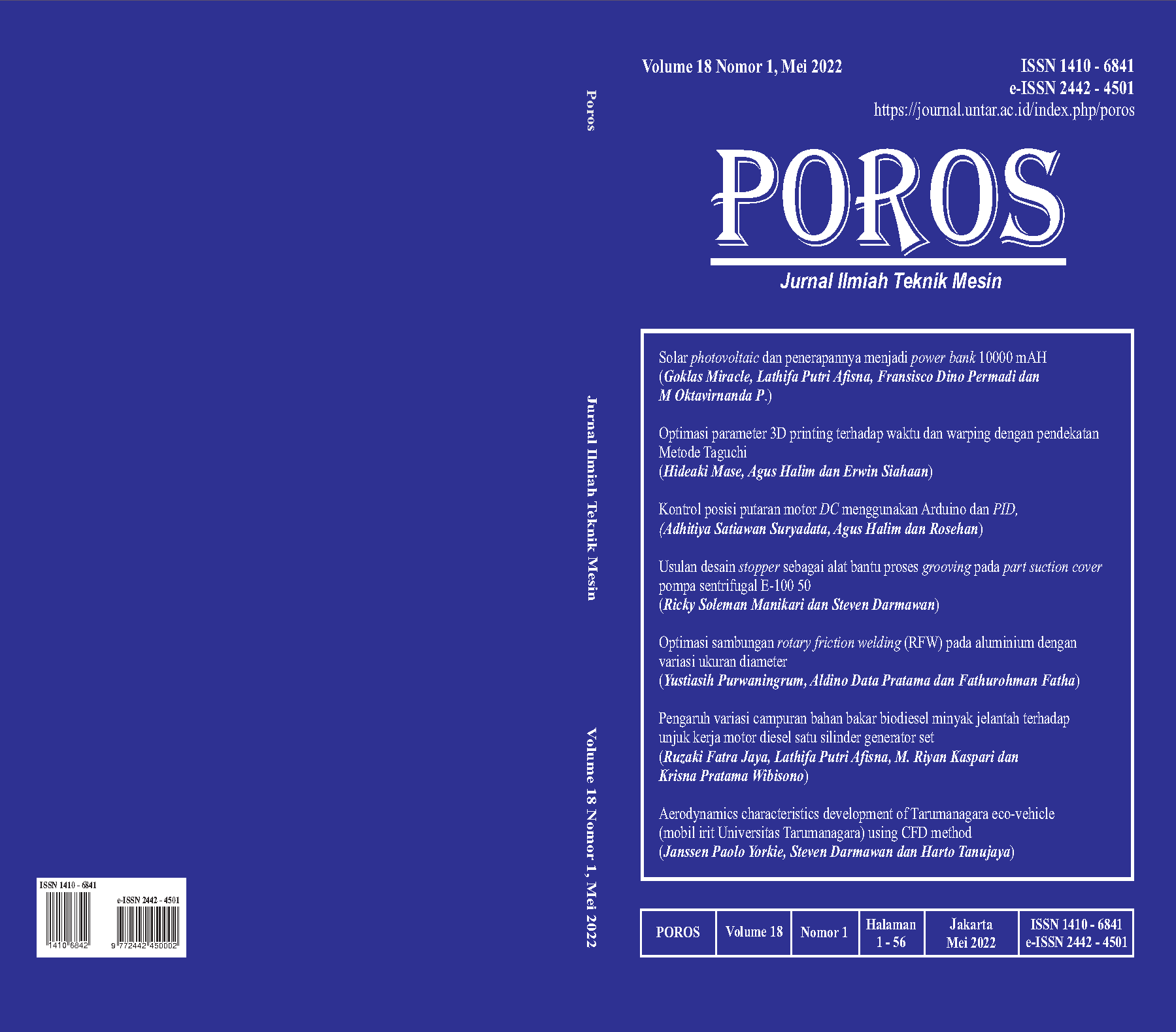OPTIMASI PARAMETER 3D PRINTING TERHADAP WAKTU DAN WARPING DENGAN PENDEKATAN METODE TAGUCHI
Main Article Content
Abstract
Article Details

This work is licensed under a Creative Commons Attribution-NonCommercial-ShareAlike 4.0 International License.

This work is licensed under a Creative Commons Attribution-NonCommercial-ShareAlike 4.0 International License.
References
“The best 3D printed consumer products - 3D Printing Industry.” https://3dprintingindustry.com/news/the-best-3d-printed-consumer-products-148352/ (accessed Sep. 22, 2021).
“FDM vs. SLA: Compare the Two Most Popular Types of 3D Printers.” https://formlabs.com/asia/blog/fdm-vs-sla-compare-types-of-3d-printers/ (accessed Sep. 22, 2021).
“Reasons Why 3D Printing is Reaching Mainstream | Smithers.” https://www.smithers.com/resources/2017/jul/reasons-why-3d-printing-is-reaching-themainstream (accessed Sep. 22, 2021).
“PLA vs. ABS: What’s the difference? | Hubs.” https://www.hubs.com/knowledge-base/pla-vsabs-whats-difference/ (accessed Sep. 22, 2021).
C. Abeykoon, P. Sri-Amphorn, and A. Fernando, “Optimization of fused deposition modeling parameters for improved PLA and ABS 3D printed structures,” Int. J. Light. Mater. Manuf., vol. 3, no. 3, pp. 284–297, 2020, doi: 10.1016/j.ijlmm.2020.03.003.
A. M. Titu, A. V. Sandu, A. B. Pop, S. Titu, and T. C. Ciungu, “The Taguchi Method Application to Improve the Quality of a Sustainable Process,” IOP Conf. Ser. Mater. Sci. Eng., vol. 374, no. 1, 2018, doi: 10.1088/1757-899X/374/1/012054.
P. Sivaiah and D. Chakradhar, “Modeling and optimization of sustainable manufacturing process
in machining of 17-4 PH stainless steel,” Meas. J. Int. Meas. Confed., vol. 134, pp. 142–152, 2019, doi: 10.1016/j.measurement.2018.10.067.
M. A. Nazan, F. R. Ramli, M. R. Alkahari, M. N. Sudin, and M. A. Abdullaah, “Process parameter optimization of 3D printer using Response Surface Method,” ARPN J. Eng. Appl. Sci., vol. 12, no. 7, pp. 2291–2296, 2017.
V. Madhav and S. Yeole, “Relative Studies on ASTM D638 Type–IV Specimens 3D,” 6th Int. 27th All India Manuf. Technol. Des. Res. Conf., no. September 2018, 2016, [Online]. Available: https://www.researchgate.net/publication/327703890_Relative_Studies_on_ASTM_D638_Type-V_Specimens_3D_Printed_using_ABS_Material.
S. Anand Kumar and Y. Shivraj Narayan, Tensile testing and evaluation of 3D-printed PLA specimens as per ASTM D638 type IV standard, no. February 2018. Springer Singapore, 2019.
Q. Ma, M. R. M. Rejab, A. P. Kumar, H. Fu, N. M. Kumar, and J. Tang, “Effect of infill pattern, density and material type of 3D printed cubic structure under quasi-static loading,” Proc. Inst. Mech. Eng. Part C J. Mech. Eng. Sci., vol. 235, no. 19, pp. 4254–4272, 2021, doi:
1177/0954406220971667.



